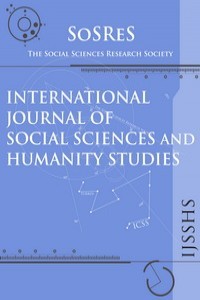EVALUATING RELATIONSHIP AMONG RELIGIOSITY, SELFESTEEM, AND IDENTIFICATION WITH TURKISH IDENTITY THROUGH STRUCTURAL EQUATION MODEL
EVALUATING RELATIONSHIP AMONG RELIGIOSITY, SELFESTEEM, AND IDENTIFICATION WITH TURKISH IDENTITY THROUGH STRUCTURAL EQUATION MODEL
Turkish Identity, Self-Esteem Religiosity, Structural Equation Model,
___
- Baumeister, R. F. (1991). Meanings of life. New York: The Guilford Press.
- Baumeister, R. F., & Vohs, K. D. (2002). The pursuit of meaningfulness in life. In C. R. Snyder & S. J. Lopez (Eds.), Handbook of positive psychology (p. 608-618). New York: Oxford University Press.
- Cagaptay, S. (2006). Islam, secularism and nationalism in modern Turkey: Who is a Turk? London: Routledge.
- Cingöz-Ulu, B. (2008). Structure of Turkish national identity and attitudes towards ethno-cultural groups in Turkey. Doctoral Dissertation, York University, York.
- Guibernau, M. (2007). The identity of nations. Cambridge: Polity Press.
- Haslam, S. A., Jetten, J., Postmes, T., & Haslam, C. (2009). Social identity, health and well-being: An emerging agenda for applied psychology. Applied Psychology: An International review, 58 (1), 1-23
- Hofstede, G. (2001). Culture’s consequences: Comparing values, behaviors, institutions, and organizations across nations. London: Sage.
- Hofstede, G. (2011). Dimensionalizing cultures: The Hofstede model in context. Online http://dx.doi.org/10.9707/2307-0919.1014 in Psychology and Culture, 2 (1),
- Jöreskog, K. ve Sörbom, D. (2001). LISREL 8: User’s reference guide. Chicago: Scientific Software International Inc, USA.
- Karakitapoğlu-Aygün, Z., & İmamoğlu, E. O. (2002). Value domains of Turkish adults, and university students. The Journal of Social Psychology, 142, 333-351.
- Kernis, M. H. (2003). Toward a conceptualization of optimal self-esteem. Psychological Inquiry 14 (1), 1-26.
- Kline, R. B. (1998). Principles and practice of structural equation modeling. New York: Guilford Press.
- Ok, Ü. (2011). Religious attitude scale: Scale development and validation. International Journal of Human Sciences, 8 (2), 528-549.
- Roccas, S. (2005). Religion and value systems. Journal of Social Issues, 61 (4), 747-759.
- Schwartz, S. H. (1994). Beyond individualism-collectivism: New cultural dimensions of values. In U. Kim, H. C. Triandis, C. Kagitcibasi, S. C. Choi, & G. Yoon (Eds.). Individualism and collectivism: Theory, method and applications (p. 85-119). London: Sage.
- Sherif, M. (1966). Group conflict and co-operation: Their social psychology. Michigan: Routledge & K. Paul.
- Tajfel, H. (1972). Social categorization. In S. Moscovici (Ed.). Introduction to Social Psychology. Paris: Larousse.
- Tajfel, H. (1978). Differentiation between social groups: Studies in the social psychology of intergroup relations. London: Academic Press.
- Tajfel, H., & Turner, J. C. (1979). An intergrative theory of intergroup conflict. In W. G. Austin & S. Worchel (Eds.). The Social Psychology of Intergroup Relations. Monterey, CA: Brooks/Cole.
- Tajfel, H., & Turner, J. C. (1986). The social identity theory of intergroup behavior. In S. Worchel and W. G. Austin (Eds.), Psychology of intergroup relations (2nd ed.; pp. 7-24). Chicago, IL: Nelson-Hall Publishers.
- Tajfel, H., & Wilkes, A. L. (1963). Classification and quantitative judgment. British Journal of Psychology, 54, 101-114.
- Turner, J. C., Brown, R. J., & Tajfel, H. (1979). Social comparison and group interest in ingroup favouritism. European Journal of Social Psychology, 9, 187-204.
- Başlangıç: 2009
- Yayıncı: Sosyal Bilimler Araştırmaları Derneği
A RESEARCH ABOUT EMPLOYEES' WORK-LIFE BALANCE AND PRESENTEEISM TENDENCY
M. Halit Yıldırım, Muhammet Saygın, Sevil Yıldırım
SOCIAL INTEGRATION: TESTING ANTECEDENTS OF TIME SPENT ONLINE
Lily Suriani Mohd Arif, Osman B. Gazzaz, Fazal Rahi, m Khan
SECURITY THREATS IN CENTRAL ASIA
PEER COMMUNICATION AND IMPACTS ON PURCHASING DECISIONS: AN APPLICATION ON TEENAGERS
Ahmad Assadzadeh, Javad Pourqoly, Amin Taslimi Baboli, Fahimeh Ahmadzadeh Deljavan
THE EFFECT OF THE SOCIAL MEDIA ON YOUNG CONSUMERS' CONSUMPTION EXPENDITURE
Fatma Çakır, Mesut Çakır, Oya Eru
SOCIAL CAPITAL IN INVOLUNTARY DISPLACEMENT AND RESETTLEMENT
Melissa Quetulio Navarra, Anke Niehof, Wander van der Vaart
ATTITUDES TOWARDS ENVIRONMENTAL ISSUES: A CASE OF BOPHELONG TOWNSHIP
